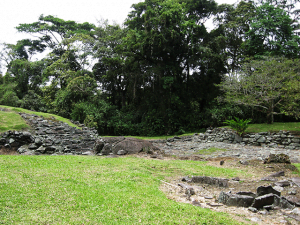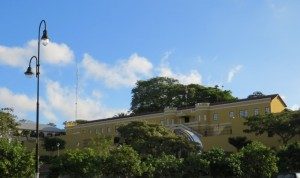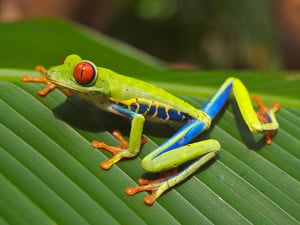These are four historical landmarks in Costa Rica, for those in search of stories to tell.
Guayabo National Monument – Precolumbian History
Inhabited by several groups, the native population of Costa Rica had influences from the Mesoamerican and the South American groups.
Being a border of both cultures and a center of trade, Guayabo, was part of this commerce, and the place where a monumental network of roads started from the mountains to the North and the Caribbean Coast (Still underground and undiscovered).
The Guayabo National Monument preserves an indigenous mound housing area, ancient roads, an aqueduct, and a cemetery. Guayabo is south from the Turrialba Volcano, and it is the biggest and most important archeological site in Costa Rica.
Turrialba town is 12 miles south of this 573-Acres. The Monument was first uncovered in 1968 an archeologist from the University of Costa Rica named Carlos Agular Piedra, Only a small portion of the ruins has been uncovered; there’s still much to be excavated. In Central America, we can usually find the Mayan or Aztec archeological sites, and the Guayabo Monument is one of the different sites, besides the previous mention, that can be found in the area. In the park, you will find a sophisticated city infrastructure as well as an aqueduct system and mysterious petroglyphs and tombs. The Gold artifact and the pottery that was unearthed from here are now on display, right at the center in San Jose; ha Costa Rica National Museum.
The place was inhabited as early as 1000 BC, and the archeologist is still unclear why this thriving city was mysteriously abandoned around 1400 AD. It’s believed to have reached its pinnacle of development in 800 AD, the stone causeways, cobbled pavements and circular mounds of the Parque Nacional Guayabo are pretty impressive. Nowadays, most archeologists believe that this city was a key religious, political, and cultural center. This impressive National Monument sits on only 10% of its total land area while the remainder 90% of the land is a premontane rainforest.
One of the last remaining stretches of the rainforest of its kind in Cartago, there is not a lot of Wildlife that can be found living in the area. There are still some animals that wonder the place one of the most notable birds is the oropendolas, which live in a sack-like nest in the tree. The impressive nest is just having everywhere, and everything created by them. Brown Jays and toucans are the commonly seen birds. And of the few mammals that live in the area are the coatis, armadillos, and squirrels. The Guayabo National Monument is a reminder of the Costa Rica that existed before the Spaniards arrive at our coasts. As we were on the border of the two major influences in the continent, Guayabo is probably one of the few remaining sites in this quite transcending pre-Columbian region that mixed two huge empires.
Cartago Ruins – The colonial times.
Columbus himself came to Costa Rica in 1502 and after his discovery of the continental area of the Americas, many Spaniards tried to get in. Until, they desisted, at first because of the hostility of indigenous and nature, and a second because, there was no gold, compared to Mexico or Perú. Finally, the country was populated by the Pacific Coast inland. And it was tremendously isolated.
Its capital city Cartago was very small, and a lot of the people sent here by the Spanish Empire were as poor as the natives themselves. There were only a few rich families that controlled everything. This is the story of two brothers of one of these families:
The Cartago Ruins stand in the middle of Cartago, with gardens in the inside and the central park of Cartago in front.
Two brothers were fighting over a woman. Not that they were fighting for her love, but one of them a priest didn’t want his younger brother to marry her, as she was a single mother and they were noble Spaniards. The discussion went up and up, until the day of the wedding when the priest interrupted the ceremony and fought his younger brother killed him inside the church. And they say, the church since then, was condemned.
The church was established in 1575 dedicated to St. James and then and it was destroyed by earthquakes several times until May 1910, and that’s why the people of Cartago say that the church is condemned. And it was never built again- Finally, the ruins were declared as a cultural patrimony 1982.
Cartago is a Costa Rica province located on the north from San Jose City, in the very center we get the Cartago Ruins, dating back the 16th century, where the city’s central park is.
Finally, the largest religious center of Cartago (And Costa Rica) is The Basilica de Nuestra Señora de Los Ãngeles.
The building Is a large church with gray and white byzantine that gives a home to ‘La Negrita de Los Angeles’, our patron saint. Who is honored by half of the population of the country by walking towards her from all locations of the country? The walk miles from their homes to ask to the ‘Negrita’ a wish and then go back to their homes.
San Lucas Island
Ah! The San Lucas Island a place full of infamous stories and horror tales. The island was a prison that was made famous by an ex-con who wrote a novel about his experience, something like Alcatraz; the book name is ‘Island of lonely men’. Written by Jose Leon Sánchez.
From 1873 to 1991, San Lucas Island was a penal island for some of the worst criminals in Costa Rica as it was quite isolated and the probabilities of escaping were almost none. It normally erroneously cited that I was the largest prison in Costa Rica, totally misconceived. It was found by the dictator Tomas Miguel Guardia Gutierrez (1871-1882) who created it specifically for political prisoners.
Being sent to San Lucas Island was a terrible prospect as prisoners’ lives were short and often spend in torture.
An interesting fact is that Tomas Guardia abolished the death penalty a year after establishing the prison. The old building of the penal island is considered ‘Patrimonio de Cultura’ or cultural heritage sites. These buildings include a historic dock that is still in use after the first dock was destroyed, they had a church, a medical center, temporary holding cells, a large concrete did use to hold a water tank, and water pumps. There are penal cells of varying security levels depending on the prisoner’s crimes. The prison says a lot of graffiti of older Latin American prisons, such as religious phrases, signatures, and drawings. There are also several water pumps and a cemetery under excavation on the island.
As a final note, when the prison was closed, the remaining prisoners did not want to move to the Puntarenas jail as they were so used to the peacefulness fo the island in the middle of the Nicoya Gulf. The time when this landmark was made, was the beginning of an era in Costa Rica. After the independence, and already set in coffee exports, Tomas Guardia was the one that brought the train to Costa Rica, and with the train the beginning of the banana company.
Costa Rica’s National Museum.
Costa Rica’s National Museum, a massive building that crowns the capital city on a hill.
Once the army barracks, the incredible museum uncovers Costa Rica’s culture, political, and ecological history. The Costa Rican National Museum is located in the country’s capital. Close enough of the Jade Museum. The fortress was built in 1917 and was originally a military barracks; the exterior walls still have many bullets lodged in them from the country 1948 civil. It became the site of the museum in 1950.
The museum has an entrance on the east side that leads to a courtyard displaying pre-Columbian artifacts and cannons from the colonial period. The museum is organized thematically in a counter-clockwise direction from the entrance with artifacts related to Costa Rica’s geological, colonial, archeological, religious, and modern history. The museum uses to have a notable collection of pre-Columbian stone tables, ceramics, and a gold room in the northeast tower. The colonial room has a notable collection of furniture and is designed to emulate the quarters that once we’re in the 18 century. The museum also exhibits the 1987 Nobel Peace Prize awarded to Oscar Arias, and bust of Jose Figueres and butterfly garden in the outside.





